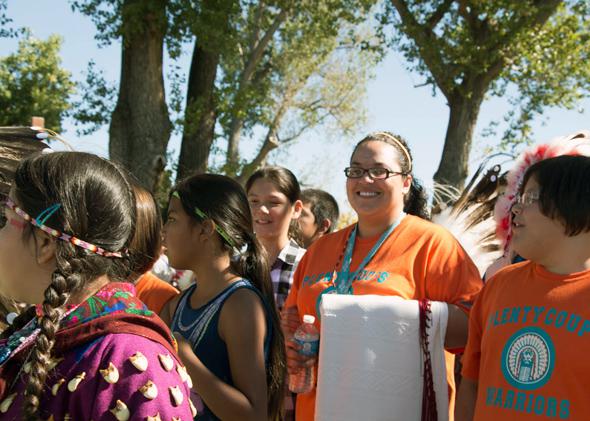Last spring, Sam Bruner, the principal of two small schools on a Native American reservation in rural Pryor, Montana, knew he needed to hire two teachers for the upcoming school year. So he drove two hours west to a job fair in Bozeman, where he set up his table and then watched as a stampede of job-hunting teachers passed him by. Of the hundreds in the large conference room that day, fewer than 10 people approached Bruner’s table. All of those who did soon lost interest after he explained where Pryor is located: on the eastern side of the Crow Reservation, 34 miles from the closest major town.
Across the country, rural schools face some of the worst teacher shortages. But schools that are isolated, poor, and underperforming—including many on reservations—struggle the most to lure teachers. Before the 2013–14 school year, for instance, Bruner needed to hire eight teachers—a full half of his staff. “It’s like asking a kid which professional sports team he’d like to join,” said Bruner. “One that’s winning, or one that’s losing?”
It’s that perception—a partial misperception in this case, since Pryor’s graduation rate has been shooting up in recent years—that may be one of the biggest obstacles to successful teacher recruitment in struggling rural districts.
Money undoubtedly matters when recruiting for any profession, but research and anecdotal experience suggest that alone it is not enough for teachers, particularly when the pay is modest in scale (and it’s almost always modest in this profession).
One survey of about 600 superintendents from rural districts, for instance, found they rated “promoting the advantages of teaching and living in the area” as far more effective on average than housing or relocation assistance and slightly more effective than competitive salaries or benefits.
One problem with financial incentives is that they usually fail to compensate for the immense material advantages of wealthier districts: higher-achieving students, more modern school buildings, more professional development.
Pryor’s subsidized housing incentive, for example, which provides teachers with housing near the school for $250 a month, has largely failed. Of the high school’s 16 teachers, only one lives in the subsidized housing. Most of the others commute from Billings and other nearby towns.
“I think the intentions were good, that teachers would come and live here,” says Dan McGee, the school district superintendent. “The problem is, most just don’t want to.”
There’s little question that life in Pryor can be isolating. Although the area is physically beautiful—rolling hills, mini mountain ranges, a large state park, and Montana’s signature sweeping sunsets—there are no bars, malls, or grocery stores around. The nearest movie theatre is an hour’s drive away. There are also few jobs, apart from teaching, for spouses or partners.
Pryor teachers are eligible for student loan forgiveness programs from both the state of Montana and the federal government, particularly if they teach hard-to-staff subjects. A science teacher, for example, who spends five years at Pryor’s Plenty Coups High School could receive up to $12,000 in student loan forgiveness from the state and up to $17,500 from the federal government. Yet the district still struggles every year to attract teachers.

Photo by Madeleine Cummings
Most of Pryor’s strongest teachers say they chose to teach in Pryor for nonmaterial reasons such as the intimacy of rural environments, the chance to make a difference in impoverished children’s lives, and the freedom and flexibility that teaching in a small town often affords.
Donna Dawson, a special education teacher from Pittsburgh, came to Pryor a couple years ago because it wasn’t “your boring suburbia school district.” After a long career serving in the Marine Corps and teaching in more cushy schools, she wanted a position where she could make a strong impact on children’s lives. Monetary incentives weren’t even on Dawson’s radar. “I’m not in it to suck every dime out of my school,” she says. “I’m here to make a difference.”
Ed Wiest came to Pryor 16 years ago for similar reasons. After many years teaching in Columbus, Montana, a much wealthier town with higher-achieving students, Wiest felt he needed a change. After seeing an online advertisement for a position in Pryor, he deliberated for weeks over whether to apply. Eventually his curiosity won out, and after a short interview the school offered him a job.
Over the years, Wiest came to appreciate the many benefits of working in a small, rural school—benefits he believes could be more overtly marketed. With small class sizes (usually fewer than 10 students), he developed deep relationships with the students and could easily track their progress from year to year. Being Plenty Coups’ sole math teacher—“I am the math department,” he jokes—feels freeing, not isolating. Wiest chooses his own curriculum, controls the pace of his lessons, and is more empowered to experiment with classroom structure.
So how can a school like Pryor attract more teachers like Dawson and Wiest? “You want to recruit almost like the military,” said Robert Maranto, the 21st century chairman in leadership at the University of Arkansas’ Department of Education Reform. The military, he adds, has successfully lured countless soldiers by messaging: “You can go to a place. Have an impact.”
Researchers from the University of Arkansas analyzed about 50 school district websites in rural communities and found that almost none of them advertised nonmaterialistic incentives, such as freedom in the classroom or the opportunity to forge close relationships with students. The lone exception was KIPP Delta, a charter school network in rural Arkansas with close ties to Teach for America. KIPP Delta included a long paragraph on its careers page about the benefits of teaching in their schools, which serve primarily students from low-income families. Teachers would “directly impact the lives of hundreds of children,” the website advertisement stated, and it concluded: “If you are looking for a place where you can grow as a professional and truly make a difference, KIPP Delta may be a perfect fit!” This one paragraph, the Arkansas researchers noted, included more promotional language than the other 53 school district websites combined.

Photo by Madeleine Cummings
Teach for America takes this approach even further (although even its popularity has ebbed in recent years). Its website presents educational inequality as a solvable problem and appeals to potential teachers’ desire for meaningful employment. The site has a blog full of upbeat and inspiring stories about teaching, and motivational phrases like “Stand up for kids” appear on almost every page. “You will struggle in ways you may not have struggled before—but the impact you can make is worth it,” the website states.
The challenge for administrators like McGee and Bruner is how to find a way to sell the benefits without sugarcoating the enormous challenges of the job or neglecting to build a sustainable teaching corps committed to staying in one place for the long haul. These are oversights sometimes cited by skeptics of the recruiting-savvy Teach for America, which focuses on bringing top college graduates to struggling communities for at least two years. After those two years, slightly over half leave their initial placements, according to one study (although a majority stay in teaching for longer than two years).
McGee says he promises teacher candidates small class sizes and close relationships with students. But Bruner is less eager to tout the best parts of the job, fearing he might cover up some of the struggles. Other superintendents say they worry they might attract too many community outsiders looking for missionary-style stints.
That last concern is why some rural districts have taken the opposite approach of TFA and have attempted to grow their own educators rather than import them from afar. Teachers from the same background and place usually have stronger ties to the community and children, and are often less likely to pack their bags when the job proves challenging. But even with local candidates, messaging can go a long way. Invariably, teachers say a financial incentive, like subsidized tuition or loan forgiveness, might pique their interest. But they ultimately came to teaching—and stayed—for the kids.
